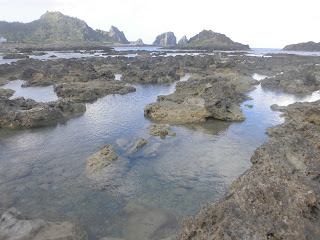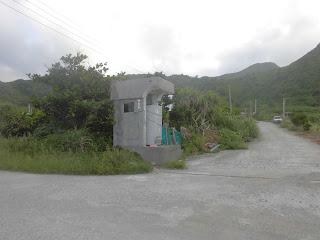我去蘭嶼玩!大部分的人應該知道蘭嶼在哪裡,但萬一如有人不知道我要解釋一下。蘭嶼在台灣島東南方,離綠島不遠。日統時代一般人過不去,所以在島上只有那裡的原住民而已。換中華民國統治台灣之後這個政策還是沒有改變。到1967年政府才把蘭嶼開放了,一般國民可以過去。因為有這樣的背景所以很多人說在蘭嶼原住民(達悟)的文化還是跟台灣島比起來更維持的。
I went to Orchid Island (Lanyu) recently. Orchid Island is an island off the south-east coast of Taiwan. It takes about two hours by boat, but I went by plane, which was only took 30 minutes from Taitung airport. Orchid Island is interesting because it's rather different from the rest of Taiwan. Under Japanese rule, the island was off-limits to most people, so aside from some small number of Japanese officials who would have been there, the island was only inhabited by its own native people, the Tao. (Historically also called "Yami".) This policy actually continued under the Chinese Nationalist government until 1967, when the island was finally opened up. As a result, the Tao culture was isolated from Han culture until far more recently than is the case with Taiwan's other native people. Even today the majority of the islanders are Tao people. Many people say this gives the island a distinctly different vibe from the rest of Taiwan.
この間「蘭嶼」という島に行ってきた。蘭嶼は台湾島の東南沖にある。船で台東から二時間ぐらいかかるが、私は台東の空港から小さな飛行機に乗って30分で着いた。蘭嶼は台湾の中ではとても独特な場所だ。日本統治時代には、日本政府がこの島を一般人に立ち入り禁止にして、少人数の日本人以外、島に住んでいたのはそこの先住民しかいなかった。この島の先住民は以前日本語で「ヤミ族」と呼ばれているが、これは日本人が付けた名前らしい。自分達の言葉にもっと近い呼び方は「タオ(達悟)族」だ。中華民国が台湾を支配してからも、蘭嶼は立ち入り禁止法令が続いて、1967年にはやっと一般人が島に渡れる様になった。お陰で、先住民の文化が台湾の他の様々な先住民と比べて割と保たれてきている。
我搭飛機過去。台東機場有這樣的裝飾。是達悟的傳統船舶。
The Taitong Airport was decorated with traditional Tao canoes.
台東空港にこの伝統的な船の飾り物があった。
到了我就馬上開始飆車環島。我立刻注意到:芋頭非常多。到處都有芋頭田。I arrived at the island and began immediately tearing around on a rented scooter. I quickly realized something: the island is overrun with taro fields.
島に着いて早速バイクで回ってみた。何分も立たないうちにタロ芋田んぼが非常に多いことに気づいた。
雖然島嶼很小可是山很高。
Despite its small size, the mountains on the island are decently tall.
小さな島なのに、山が高い。
島上涼亭好多。不但旅客會用,其實原地人也常常在涼亭裡休息。這只是我的感覺而已,不知道是不是正確,但是我感覺到蘭嶼人跟台灣比起來比較習慣在外面打發時間。到處的涼亭都有人集中說說話。是因為蘭嶼整年都很熱嗎?
There are these outdoor gazebo things all over the island. Not only do tourists who have gotten too much sun use them, but many of the locals also seem to hang out in them. It seems like there is more of a "hang outside and chat" culture on the island than there is in the rest of Taiwan.
蘭嶼に下の写真に見える様な休憩所がたくさんあった。観光客だけじゃなくて、現地の人もけっこう利用していた。私の感では、蘭嶼は外で時間過ごして人とお喋りする習慣が強く根付いている様だった。
在這座島上山羊,豬,狗,貓都很自由自在地過日子。
The island is filled with pigs, goats, cats and dogs who roam free.
山羊、豚、猫、犬、みんな自由に外でぶらぶらしていた。
蔣介石。看起來好久沒有維修。我猜應該一般達悟人不太關心蔣介石。因為到1967年這座島跟台灣島沒有交流,所以蔣介石好像外國歷史上的人物吧。
There was this very lonely-looking bust of Chiang Kai-shek. It looks like the staircase leading up to it hasn't been repaired in quite some time. Since the island only started to have normal contact with the Taiwanese mainland in 1967, Chiang Kai-shek (who died in 1975) is almost like a figure out of a foreign country's history from the point of view of Orchid Island.
一応蒋介石の銅像があった。でも長い間誰も修理していないみたい。1967年まで台湾と交流があまりなかったこの島では、蒋介石はおそらく外国の歴史人物という感覚かもしれない。
紅燈
Island traffic light
赤信号
我到這裡的時候我還不知道,可是後來知道了這個在島南部的海港是核廢料貯存場專用的。
I didn't know it at the time, but this harbor is the harbor for the nuclear waste facility on the island.
この港は核廃棄物の保管所専門の港だ。
山上常常有雲霧。
這個巨石看起來什麼?這應該是「龍頭岩」。(我忘記了。)
I think this is "Dragon Head Rock".
これはたしか、「龍頭岩」だと思う。
啊~。我不是故意地這麼早提供這個不愉快的話題。第一天我隨便向南騎就馬上到了這裡。但說到蘭嶼非說核廢料不可。我在島上住之中,看到很多抗核廢料或是核能的招貼畫。按照達悟人的說法,政府把貯存場建完了之後才告訴他們是什麼設備。聽說為了安撫島民台電送給他們免費的電力,但如果受到核能放射的影響的話,你會選冷氣用到飽嗎?
Unfortunately, since I started out by going south, I already have to touch upon an unpleasant subject. Orchid Island has a nuclear waste facility. All over the island I saw anti-nuclear power posters. According to what many of the islanders say, they didn't know what the government was building when it was building the storage facility, and they only found out that it would house nuclear waste after it was finished. The power company tried to pacify them by providing free electricity, but not surprisingly, given the risk of nuclear contamination, many islanders are still not satisfied and want to see the facility removed. The whole affair stinks of racism/ethnicism, with Taipei elites deciding to place something unpleasant and dangerous in an area primarily inhabited by people of a different ethnicity than them.
南向かって行ったせいで、すぐここに着いて残念な話題に触れることになる。でも触れないわけにはいけない。ここは核廃棄物保管所だ。島中には「核発電反対」とか「廃棄物保管所反対」の様なポスターをたくさん見てきた。タオ族の話によると、政府がこの保管所を作った時は何の施設かちゃんと教えなかった。出来上がってから教えたので、島民の猛反対を受けた。お詫びに台湾電力は無料で電力を島民に与えているが、やはりそれでも納得いけない。ある意味で沖縄の基地問題に似ていると思う。お金をやるからなんでも解決できるわけじゃない。
芋頭應該耐鹽害力很高吧。離海邊很近的芋頭田蠻多。
Lots of taro fields are pretty close to the sea (well, that's where the flat land is) so it seems they must be fairly tolerant of salt.
タロ芋は塩害に強いのかな?海岸沿いの田んぼはたくさんあった。
基督教/天主教好像蠻多。每個部落有教會,反之我只看到一座廟。跟台南真的不太一樣。
Every single town had at least one church in it. Many aboriginal communities in Taiwan are heavily Christian from what I understand. On the flip side, I only saw one Taoist temple during my stay on the island. This is a pretty stark contrast from the situation in Tainan, where you can't walk twenty yards without tripping over a temple.
蘭嶼はクリスト教が多い様だ。(基本的に台湾の先住民はクリスト教がかなり浸透している。)村落毎に教会があったのに、道教の廟は一箇所にしか見ていない。台南と状況がだいぶ違う。
林投樹
The amusingly-named Screw Palm Tree
アダンの木。(タコの木)
這個標誌的意思說「眼睛」。原本是在船上畫的。怎麼黑暗,海上發生什麼問題,這個標誌會幫船看清楚平安地回家。
These symbols were everywhere on the island. They're (very stylized) eyes. Traditionally, they were painted on canoes so that fishermen would be able to get home even if they were out past dark, or in unsafe waters.
このシンボルは「目」らしい。昔は漁師のお守りみたいなものだった。船にこれ描いたら、夜がどんなに暗くなっても、海上ではどんな危険が発生しても、船ははっきり見えるから家に帰ることができる。みたいな意味。
貓!
Cats!
猫発見!
部落的名字不是華語,所以很有趣。
The town names are are written in Tao, which looks very different from Mandarin. (Well, not surprising since the two languages are totally unrelated.)
村落の名前はタオ語で書いているので、中国語と印象が全然違う。
島上的國小。一般來說在台灣怎麼鄉下,偏僻的地方,學校還是很大,很厲害。我把這件事看成是表現台灣人很重視教育。
No matter how rural an area you go to in Taiwan, the school buildings are still impressive and large.
こんな田舎臭い離島にも、立派な学校がある。(しかも七つぐらい。たしか小学校が六つもあって、中学校が一つあった。)台湾は教育を重視するからだろう。
乾潮時可以走到礁上。
It was low tide, so I walked out onto the reefs.
引き潮だから、岩礁を歩いてみた。
傳統船的體驗。
Traditional canoe rides for tourists
伝統的な船体験もできる。
日本政府做的坑道。以前大家都要通過這個坑道才可以走路到島嶼對方。現在有馬路,所以坑道變成觀光資源。
This tunnel was dug during the Japanese period. It used to be the only way around this rock here because the paved road in the front of the photo wasn't around at the time.
日本統治時代にこの舗装された道路はもちろんなかった。唯一あった道はこのトンネルを通ったらしい。
進去看看、、、
You can go in if you want.
對方很低。
The entrance on the other side is really low.
こっち側は偉い低い!
這裡以前應該是軍用地。
It looks like there was a military base here previously.
軍基地の跡だろう。
只是廢墟而已,但看起來美術。
Unintentional art.
廃墟だけど、何か美術っぽい。
下次還有很多我想介紹的!
More to come!
まだ紹介したいことたくさんある!




































































No comments:
Post a Comment